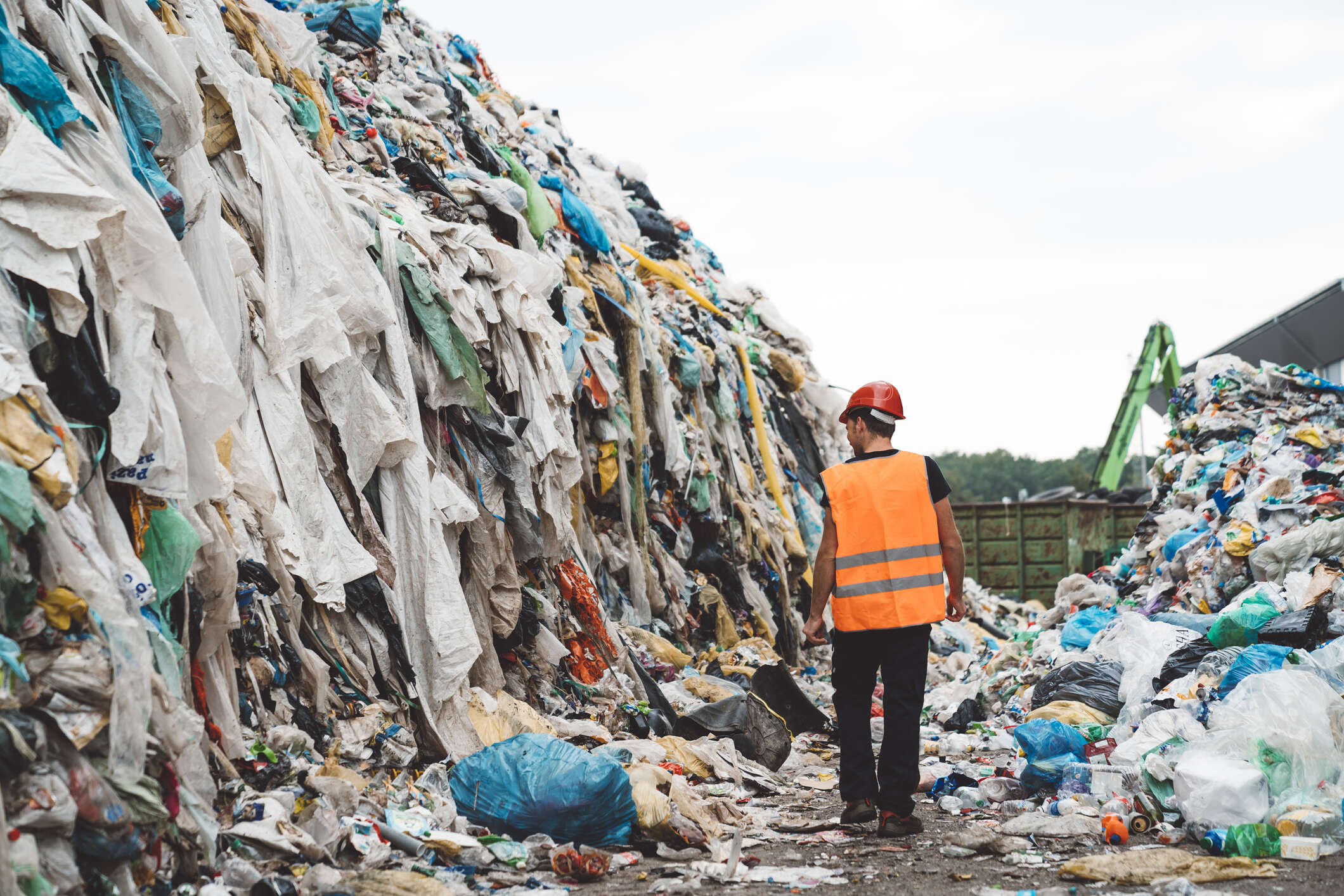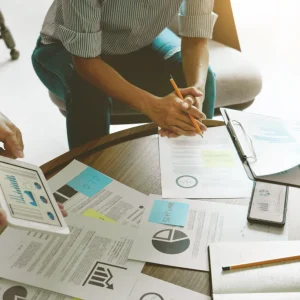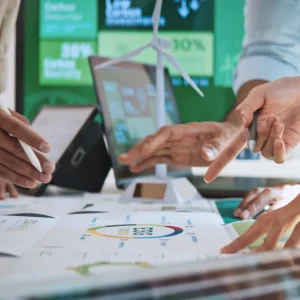
The UK won’t achieve its net zero carbon emissions goal without renewed progress on recycling and waste management, the National Infrastructure Commission warned last year. Alongside renewable energy, the move to a circular economy – in which products are reused and recycled as a matter of course – is seen as vital to averting climate change. This requires tracing products and their materials across supply chains, a task to which blockchain is ideally suited, according to its advocates. And while a flurry of pilot projects has not led to widespread adoption so far, they may yet be proven right.

‘For a circular economy to function it is not only resources which need to circulate, but also information.’ (Photo by Ziga Plahutar/iStock)
Use cases for blockchain in the circular economy
While much of the fight against climate change is focused on energy production, 45% of global emissions are produced during the manufacturing of goods. Increasing recycling and reuse in five areas – cement, aluminium, steel, plastics and food – could cut those emissions by nearly half, according to the Ellen MacArthur Foundation, equivalent to eliminating all emissions from transport. Meanwhile, 90% of biodiversity loss and water stress is caused by resource extraction or processing.
Progress on reuse and recycling has been limited so far, however. According to EU figures, the UK’s rate of circular material reuse – the proportion of materials that are reused or recycled – crept up from 14% in 2020 to 16% in 2019 (The EU average in 2020 was 12%).
Information is essential for a circular economy that “decouples economic activity from the consumption of finite resources”. Without knowing what a product is made of, it cannot be recycled; without knowing how it has been used, the potential for reuse is also unknown. “For a circular economy to function it is not only resources which need to circulate, but also information,” Dutch start-up Circularise notes.
Crucially, for reuse and recycling to be maximised, information about a product's component materials and its usage must pass between the various participants in its supply chain and, after sale, its owners. Proponents see blockchain technology as the ideal mechanism for this, due to its transparency and traceability. Transactions on a blockchain are stored in a distributed fashion and verified collectively, ideal for processes that cross multiple organisations, many of which will never interact.
This doesn't mean the all information is available to everyone. Permissioned blockchains, typically used in business applications, limit who can access which data based on their role in the network (they also do not incorporate mining, which accounts for the woeful environmental impact of cryptocurrencies).
Other blockchain functions that could have circular economy applications include smart contracts – automated functions triggered by events on a blockchain, such as pricing a piece of equipment for resale based on how often it has been used – and tokenisation. The latter could encourage participants to share data, or take some other beneficial action, in exchange for blockchain-specific currency.
Pilots and piecemeal progress
The late 2010s saw a blossoming of pilot projects and start-ups applying blockchain to supply chains. Many of these have a sustainability angle, and some could support circular economy applications.
Examples include Porsche, which uses technology from Circularise to trace the provenance and carbon impact of the materials used in the car parts it buys. In 2020, fashion label Alexander McQueen set up McQ, an online community that allows collectors to register ownership of their luxury garments, enabling resale. This feature is based on blockchain technology from Australian start-up Everledger.
More recently, oil and gas giant Shell revealed that it has created blockchain-based digital passports for its equipment. "The blockchain-based decentralised digital passport creates a unique digital ID for a piece of equipment and records any digitally verified state changes to that digital asset," the company explained in a recent blog post. "This digital asset and its immutable history can then provide a single source of truth throughout the life cycle of the equipment."
The European Commission, meanwhile, recently issued a tender for prototypes of a 'digital product passport', designed to record the materials used in batteries and electronic goods throughout their life so they can be reused or recycled more effectively. "Particular emphasis should be given to... digital technologies such as artificial intelligence, internet of things and blockchain," the tender says.
Blockchain and the circular economy: the challenges
So far, however, such projects have been piecemeal, providing only slivers of the closed-loop required to substantially reduce material extraction. More to the point, few have progressed beyond the pilot phase. This absence of concrete progress is starting to become apparent: last year, IT analyst Gartner placed 'supply chain blockchain' at the peak of inflated expectations in its supply chain strategy hype cycle.
For some, it has already edged towards the trough of disillusionment. “Less than 12 months ago, I thought ‘this is a dead end. It just ain't happening,'" says Dr Hilde Heim, a senior lecturer in fashion communication at Manchester Metropolitan University. Earlier this month, Heim published a study based on interviews with fashion brands and technology providers about their efforts to use blockchain to boost reuse and recycling in the apparel supply chain.
The results were dispiriting. Although there have been successful pilots, interviewees reported considerable challenges in achieving more widespread adoption. Some of these were technical, such as the need for blockchain-based systems to interoperate with legacy systems. These technical challenges are especially acute for SMEs, Heim notes, which make up more than 50% of the fashion supply chain.
Another, perhaps greater challenge is “how to get all suppliers up and downstream on board, which is a significant requirement for achieving transparency”, Heim's interviews revealed. A company trying to encourage suppliers and competitors to share information might be viewed with suspicion – a challenge other researchers have identified. "The question remains how a technology might be able to create trust, if there is a lack of trust in the first place," mused a 2020 study from Leuphana University's Centre for Sustainability Management.
The question remains how a technology might be able to create trust, if there is a lack of trust in the first place.
Heim also discovered a reluctance to create wholly transparent supply chains, which could require companies to divulge sensitive information. “Developers are finding that blockchain is not always wanted in its ‘purest’ form by large-scale firms,” her study notes.
A year ago, Heim saw these challenges as insurmountable. "The ROI just didn't seem to be there," she says. Blockchain would require "far too much investment for what you get out of it”.
Now, though, "I am actually feeling a bit more positive about it,” Heim says.
Blockchain and the circular economy: reasons for optimism
One reason for Heim's optimism is a pilot project by the UN Economic Commission for Europe to create a blockchain to support transparency in the cotton supply chain. Cotton cultivation alone accounts for 16% of the world's total pesticide use, according to the UN; the cotton in a single T-shirt requires 2,700 litres of water to grow.
For the pilot, the University of Applied Sciences and Arts of Italian Switzerland developed an open source public blockchain, based on Ethereum, that collects and shares traceability data for cotton products. The pilot confirmed blockchain's potential to the "immutable and trustworthy data storage with distributed access available to all implementing partners," the UN said in a progress report last year.
The UN project has signed up some major fashion brands, Heim says, a sign that they are beginning to take traceability seriously – another cause for optimism. This, she adds, may reflect the emergence of extended producer responsibility (EPR) rules, such as those introduced in France in 2017, which hold textile producers accountable for the proper disposal of their products. The UK government is currently consulting on EPR rules for textiles.
Meanwhile, technological advances are enabling more sophisticated approaches to information sharing. Privacy-preserving technologies such as confidential computing, in which sensitive data is processed in isolation from other systems, and ‘zero-knowledge proofs’, which can verify true or false statements without exposing sensitive data, could reassure organisations that data shared on a blockchain-based system won’t fall into the wrong hands, explains Petko Karamotchev, CEO of technology consultancy Industria.
Circularise's platform, for example, incorporates zero-knowledge proofs to allow participants to ask questions about a product, such as 'Does the product contain less than five grams of mercury?'. If the question has come from an appropriate source – a recycler, for example – the platform can provide the answer without disclosing any sensitive data, the company claims.
The Digital Sandwich project – a pilot backed by Innovate UK that aims to improve traceability and reduce waste in the food supply chain, centred on sandwich maker Raynor Foods – incorporates Corda.net, a distributed ledger that, unlike a blockchain, does not make all transactions visible to all participants. Instead, only the parties to a given transaction can view its details, explains Karamotchev, who is advising the project.
So while blockchain in the supply chain might be entering its post-hype slump, there are signs that it (or closely related technologies) could prove useful in realising the circular economy in future.
What’s most needed, Karamotchev believes, are ‘business networks’, in which participants in a supply chain can align their information needs. This could be a new role for trade associations, he says, or an opportunity for start-ups. The need for a more networked view of business processes has led Karamotchev's company to shift the focus of its communications: "We are no longer talking about blockchain in general," he says. "We are talking about business networks and business process management in a multi-party world."
Building these networks may be easier said than done, however. Fostering collaboration among participants in a supply chain, many of whom may be competitors, is the defining challenge for the circular economy, says Rémy Le Moigne, CEO of circular economy consulting firm Gate C. "One of the challenges of any circular economy initiative is to build the ecosystem," he says. This, he adds, is far trickier than building a technical solution to assist that ecosystem, however sophisticated.






